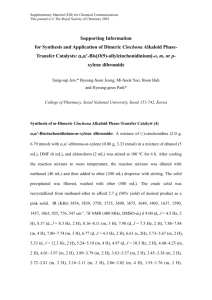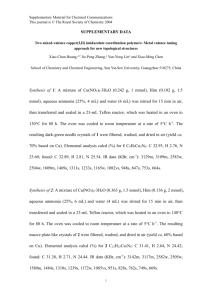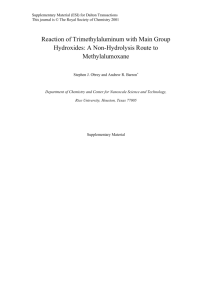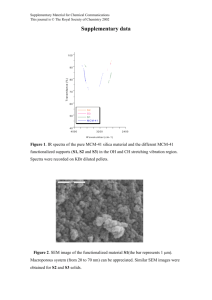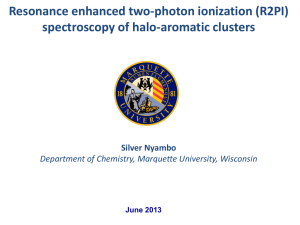Experimental - Royal Society of Chemistry
advertisement
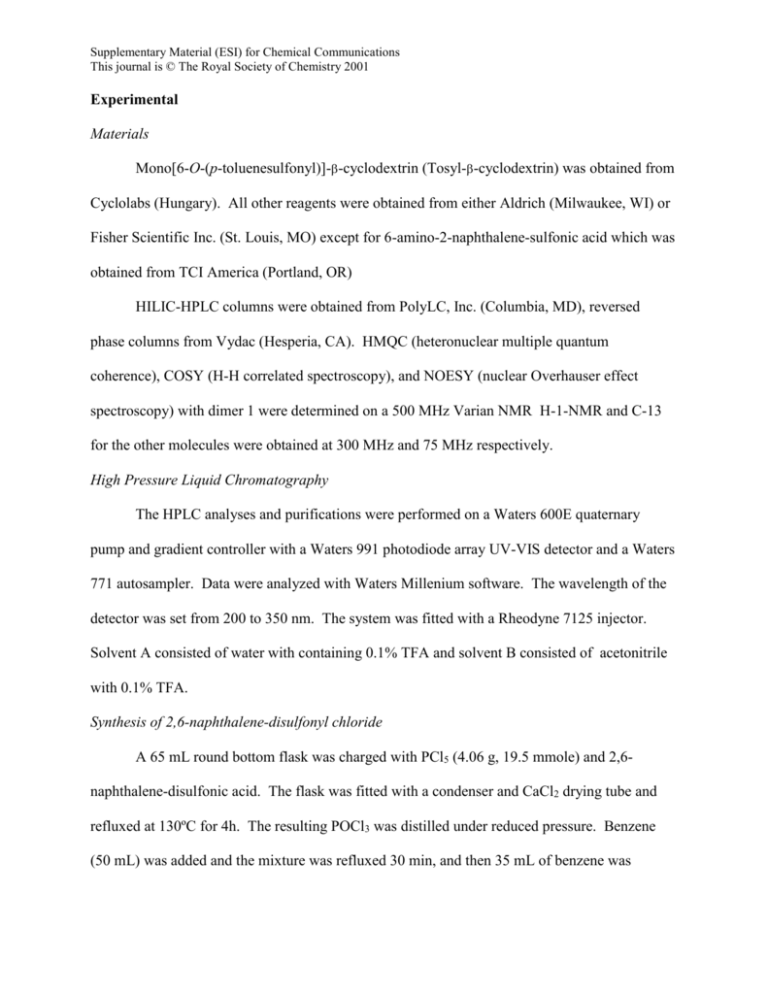
Supplementary Material (ESI) for Chemical Communications This journal is © The Royal Society of Chemistry 2001 Experimental Materials Mono[6-O-(p-toluenesulfonyl)]--cyclodextrin (Tosyl--cyclodextrin) was obtained from Cyclolabs (Hungary). All other reagents were obtained from either Aldrich (Milwaukee, WI) or Fisher Scientific Inc. (St. Louis, MO) except for 6-amino-2-naphthalene-sulfonic acid which was obtained from TCI America (Portland, OR) HILIC-HPLC columns were obtained from PolyLC, Inc. (Columbia, MD), reversed phase columns from Vydac (Hesperia, CA). HMQC (heteronuclear multiple quantum coherence), COSY (H-H correlated spectroscopy), and NOESY (nuclear Overhauser effect spectroscopy) with dimer 1 were determined on a 500 MHz Varian NMR H-1-NMR and C-13 for the other molecules were obtained at 300 MHz and 75 MHz respectively. High Pressure Liquid Chromatography The HPLC analyses and purifications were performed on a Waters 600E quaternary pump and gradient controller with a Waters 991 photodiode array UV-VIS detector and a Waters 771 autosampler. Data were analyzed with Waters Millenium software. The wavelength of the detector was set from 200 to 350 nm. The system was fitted with a Rheodyne 7125 injector. Solvent A consisted of water with containing 0.1% TFA and solvent B consisted of acetonitrile with 0.1% TFA. Synthesis of 2,6-naphthalene-disulfonyl chloride A 65 mL round bottom flask was charged with PCl5 (4.06 g, 19.5 mmole) and 2,6naphthalene-disulfonic acid. The flask was fitted with a condenser and CaCl2 drying tube and refluxed at 130ºC for 4h. The resulting POCl3 was distilled under reduced pressure. Benzene (50 mL) was added and the mixture was refluxed 30 min, and then 35 mL of benzene was Supplementary Material (ESI) for Chemical Communications This journal is © The Royal Society of Chemistry 2001 distilled from the reaction mixture. After the reaction mixture was cooled to 4ºC, the resulting white solid was filtered and washed with cold benzene (3.2 g recovered). Synthesis of 2,6-naphthalene-dithiol A 500 mL round bottom flask was charged with glacial acetic acid (220 mL) and SnCl2 (46.4 g, 245 mmol). HCl gas was bubbled into the mixture until all of the SnCl2 had dissolved. The reaction mixture was heated to 80ºC and 2,6-naphthalene-disulfonyl chloride (3.2 g, 9.8 mmol) was added in portions which produced vigorous evolution of gas. After the addition was complete, the reaction was refluxed at 90ºC for 2 h then cooled to room temperature. Then the mixture as poured onto HCl (concentrated, 140 mL) and further cooled in an ice bath. After standing overnight, a white solid was filtered and washed with water. 0.743 g recovered, 39 % yield. M.P.186-190ºC (M.P. reported 183-185ºC), 1H NMR (500 MHz, DMF-d7) 7.84 (s, 2H), 7.71 (d, J = 10 Hz, 2H), 7.46 (d, J = 10. Hz), 5.27 (s, 2H). Synthesis of dimer 1 Mono[6-O-(p-toluenesulfonyl)]--cyclodextrin (Tosyl--cyclodextrin, 500 mg, 0.388 mmol) was dissolved in 2.5 mL DMF (distilled from CaH) and heated to 85°C. KI (0.208 g, 1.25 mmol) was added and the reaction was monitored by RP-HPLC (C-18, Vydac, 300Å, 5 m, 4.6 x 250 mm) with a gradient of 5% to 40% solvent B in 30 min (linear, 1 mL/min). The conversion of tosyl- to Mono[6-O-(iodo)]--cyclodextrin (iodo--cyclodextrin) was complete in 2h. 2,6-naphthalene-dithiol (37 mg, 0.19 mmol) was then added, no evidence of reaction was observed in 22h. After the addition of NH4HCO3 (81 mg, 1 mmol), a component with a UV absorption spectra characteristic of 2,6-naphthalene-dithiol appeared. This component eluted with broad and irregular peak shape so the reaction progress was monitored by comparison of the area of iodo--cyclodextrin with that of the tosylate anion. After no further decrease in the ratio Supplementary Material (ESI) for Chemical Communications This journal is © The Royal Society of Chemistry 2001 of the peak area of iodo--cyclodextrin relative to that of the tosylate anion, the reaction was filtered to remove solids. The isolated solids were washed with DMF. The combined washings and filtrate were poured onto 100 mL acetone and the resulting white precipitate was filtered and washed with acetone (3 x 25 mL). Dimer 1 was purified by hydrophilic interaction chromatography (HILIC). The crude mixture (316 mg) was purified in batches with a HILICHPLC column (polyhydroxyethyl-aspartamide, 300Å, 5 m, 9.4 x 200 mm) with a gradient of 25% to 50% A in 30 min (4 ml/min, linear). Fraction purity was assessed by HILIC-HPLC (polyhydroxyethyl-aspartamide, 300Å, 5 m, 4.6 x 200 mm) with a gradient of 25% to 50% A in 30 min (1 ml/min, linear). Fractions containing the major component were lyophilized to yield 98 mg of a white powder. TLC (silica gel, butanol:ethanol:water 5:4:3) revealed two components (50% H2SO4 in ethanol), -cyclodextrin (Rf = 0.8) and dimer 1 (Rf = 0.5). Repurification of 50 mg on silica gel (10 cm x 30 cm, butanol:ethanol:water 5:4:3) afforded 12 mg of dimer 1 as a white powder. 1H NMR (500 MHz, DMF-d7, 6.6. mM) 7.25-7.37 (aromatic, 6H), 5.94 (secondary hydroxyl, 28H), 4.95 (anomeric, 14H), 4.64 (primary hydroxyl, 12 H), 3.72-4.12 (H3,H4,H6, 52H), 3.3-3.7 (H2,H5, resonances obscured by water), 2.63 (6A methylene, 4 H) MALDI-MS observed: (M + Na)1+ 2449. MAVE = 2426 MCALC 2425 for C94H144O68S2 While both tosyl- and iodo--cyclodextrins exhibited good peak shape and were well resolved by C-18 HPLC (Vydac, 300Å, 5 m, 4.6 x 250 mm) column, the broad elution pattern of dimer 1 made it difficult to assess whether it was resolved from other components in the reaction mixture. There was no improvement on either a polymeric C-18 (Hamilton, PRP-1, 4.6 x 250 mm) or a diphenyl RP-HPLC column (Vydac, 300Å, 5 m, 4.6 x 250 mm) (data not Supplementary Material (ESI) for Chemical Communications This journal is © The Royal Society of Chemistry 2001 shown). However, great improvement was observed by HILIC-HPLC (hydrophilic interaction UV (259 nm) chromatography). 0 5 10 15 20 25 30 20 25 30 min UV (259 nm) Purified dimer 1 evaluated by RP-HPLC (C18) 0 5 10 15 min Purified dimer 1 evaluated by HILIC-HPLC (polyhydroxyethylaspartamide) Supplementary Material (ESI) for Chemical Communications This journal is © The Royal Society of Chemistry 2001 allowing baseline resolution of dimer 1 from iodo--cyclodextrin and side products. The basis of separation in HILIC chromatography is interaction of hydrophilic groups of the analyte with the hydroxyl surface. The resolution was maintained on the semi-preparative column. However, a large amount of -cyclodextrin co-eluted with dimer 1 during its purification. Presumably, cyclodextrin was formed by hydrolysis of either tosyl- or iodo--cyclodextrin during the reaction. A second purification on an open column with silica gel resolved -cyclodextrin from dimer 1 in an overall 3.5% yield. Dimer 1 was pure by HILIC-HPLC and no -cyclodextrin was detected by staining on TLC Table A1 Shifts of CH2 and CH protons and carbons of the cyclodextrin residues of dimer 1 1 Carbon 1 2 3 4 5 6 5A 6A 13 H 4.95 3.45 3.85 3.77 3.49 3.81 3.45 2.63 C 105.0 75.6 76.1 74.9 84.5 61.9 62.5 56.1 SR 6 OH 6 5 4 O 1 3 HO O 2 OH Ring A 5 O1 3 2 4 HO O OH Ring B-G Figure A1 Designation of carbons and glucose residues of dimer 1 Synthesis of 6-(4-tert-butyl-phenylamino)-naphthalene-2-sulfonic acid (BNS) A 250 mL round bottom flask was charged with sodium bisulfite (15.0 g) and 6-amino-2naphthalene-sulfonic acid (1.60 g, 7.17 mmol) and 30 mL water. After the mixture was heated to reflux, 4-tert-butyl-aniline (3.5 mL, 22.0 mmol) was added and the mixture was refluxed for 24 Supplementary Material (ESI) for Chemical Communications This journal is © The Royal Society of Chemistry 2001 h. After the mixture was cooled to room temperature, the precipitate was filtered and washed with 150 mL water and three times with methylene chloride. The methylene chloride washings were saved and the remaining solid was suspended in methylene chloride (100 mL) with triethylamine (3 mL). After stirring for 48 h, the supernatant and the methylene chloride washings were combined and concentrated in vacuo. Recrystallization from methylene chloride and benzene produced a light pink solid (0.417 g) recovered as the monotriethylamine salt (13% yield). 1H NMR (300 MHz, DMSO-d6) 8.39 (s, 1H), 7.97 (s, 1H), 7.80 (d, 1H,), 7.57 (q, 2H), 7.15-7.41 (m, 6H), 3.12 (q, 6H, J = 7.2 Hz), 1.29 (s, 9H), 1.16 (t, 9H, J = 7.2 Hz) ES-MS observed m/z: (M + H)1+ 356, (M + Na)1+ 378, (M + K)1+ 394, (M + N(C2H5)3)1+ 457, (M + N(C2H5)3 + Na)1+ 479, (M + N(C2H5)3 + K)1+ 496, MAVE = 355; M CALC = 355 for C20H21NO3S Synthesis of 1,7-(ethylcarbamoyl)-cyclen Cyclen (0.470 g, 2.73 mmol) was added to 15 mL 10 N HCl and the acidity was adjusted to pH 2-2.5 (paper) with 10% HCl. After cooling to 0ºC, freshly distilled ethylchloroformate (0.34 mL, 3.5 mmol) was added. The reaction was allowed to stir for 24 h. After addition of 10 M NaOH to pH 10, the aqueous mixture was extracted twice with 25 mL chloroform, which was dried with MgSO4. Concentration of the chloroform extract afforded 0.343 g yellow oil (40% yield). Rf = 0.4 (2:2:1 chloroform:methanol:ammonium hydroxide); 1H NMR 300 MHz (methanol-d4) 4.82 (bs, 2H (q, 2H, J = 7.1 Hz), 3.56 (bt, 8H), 3.06 (bd, 8H), 1.28 (t, 6H, J = 7.1 Hz) ES-MS observed m/z: (M + H)1+ 317, (M + Na)1+ 339, MAVE = 316, MCALC = 316 for C14H28N4O4 Synthesis of 1,7-(ethylcarbamoyl)-4,10-(4-tert-butylphenylmethyl)-cyclen 1,7-(ethylcarbamoyl)-cyclen (0.343 g, 1.08 mmol) was dissolved in acetonitrile (10 mL) followed by the addition of diisopropylethylamine (0.96 mL, 5.5 mmol). 4-tert- Supplementary Material (ESI) for Chemical Communications This journal is © The Royal Society of Chemistry 2001 butylbenzylbromide was added in portions over 20 min. The flask was fitted with a CaCl2 drying tube and was allowed to stir overnight at room temperature. After filtration of a white precipitate, the supernatant was mixed with chloroform and extracted with 10 mL of water. The chloroform extract was dried with magnesium sulfate (anhydrous) and concentrated in vacuo. The target compound was isolated by RP-HPLC (Vydac, 300Å, 15-20 m, 22 x 250 mm) with a gradient of 47% B isocratic for 15 min followed by a gradient of 47% to 95% solvent B in 25 min (linear, 15mL/min). Fraction purity was assessed by RP-HPLC (C-18, Vydac, 300Å, 5 m, 4.6 x 250 mm) with a gradient of 25% to 90% solvent B (20 min, linear, 1.0 mL/min). Crude material (322mg) was loaded in three equivalent batches and 234 mg of the target compound was recovered (73% yield). ES-MS observed m/z: (M + H)1+ 609, (M + Na)1+ 631, (M + K)1+ 647, MAVE = 608, MCALC = 608 for C36H56N4O4 Synthesis of 1,7-(4-tert-butylphenylmethyl)-cyclen (BBC) 1,7-(ethylcarbamoyl)-4,10-(4-tert-butylphenylmethyl)-cyclen (195 mg, 0.32 mmol) was heated to reflux in ethylene glycol (5 mL), with KOH (528 mg, 9.4 mmol) and hydrazine (0.28 mL, 8.6 mmol) for 3 h. After cooling, water (25 mL) was added and the aqueous layer was extracted with three times methylene chloride. The methylene chloride extract was concentrated to a pale yellow oil (84.7 mg). This crude mixture (84.7 mg) was loaded onto a C-18 (Vydac, 300Å, 15-20 m, 22 x 250 mm) HPLC column with a gradient of 25% to 90% solvent B in 20 min (linear, 20 mL/min). Fraction purity was determined by RP-HPLC (C-18, Vydac, 300Å, 5 m, 4.6 x 250 mm) with a gradient of 25% to 90% solvent B (20 min, linear, 1.0 mL/min). Fractions containing BBC were pooled and concentrated by centrifugal evaporation to yield 14.4 mg (10%). 1H NMR 500 MHz (CH3OH-d5) 7.48 (d, 4H, J =7.8 Hz), 7.27 (d, 4H, J =6.9 Hz), 3.82 (s, 4H), 3.24 (bs, 8H), 2.87 (s, 8H), 1.34 (s, 9H); 13C NMR 126 MHz (CH3OH-d5) Supplementary Material (ESI) for Chemical Communications This journal is © The Royal Society of Chemistry 2001 1quaternary carbon of tert-butyl group not observed due to insufficient sample concentrationES-MS observed m/z: (M + H)1+ 465, (M + Na)1+ 487, MAVE = 464, MCALC = 464 for C30H48N4 Synthesis of Cu-1,7-(4-tert-butylphenylmethyl)-cyclen (Cu-BBC) BBC (200 g, 100 L, 0.43 mole, 2 mg/mL, methanol) was added to a 1.5 mL polypropylene vial. After dilution with aqueous ammonium acetate (800 L, 100 mM, pH 6.4), copper (II) acetate (0.43 mole, 86.1 L, 5mM in 100 mM ammonium acetate, pH 5.5) was added. The final volume was adjusted to 1000 L with aqueous ammonium acetate (14 L, 100 mM, pH 6.4). The mixture was allowed to react at 37°C for 1 h. The extent of the reaction was assessed by RP-HPLC (Vydac diphenyl, 300Å, 5 m, 4.6 x 250 mm) with a gradient of 20% to 80% B in 30 min (linear, 1 mL/min). The reaction was complete in 1h. ES-MS observed m/z: (M+ H)1+ 526 MAVE = 525 MCALC = 525 for C30H46CuN4 Determination of Equilibrium Dissociation Constants Fluorescence spectra were recorded on a Perkin-Elmer LS-50 spectrophotometer in quartz cuvettes (excitation 370 nm, emission observed 400-500 nm). Stock solutions were prepared with sodium phosphate buffer (20 mM, pH 7.5). Utilizing GraphPad Prism® software (GraphPad Software Inc., San Diego, CA), the data were fit by non-linear regression to: F = (FMAX )[BNS]/ (KD + [BNS]) where F is the observed fluorescence intensity corrected for background fluorescence from unincorporated BNS and dimer 1 to determine values for KD (21,22). To determine the IC50 value, the data were fit by non-linear regression to: FOBSV = T + (T – B)/ 1 + 10exp(log[Cu-BBC] – logIC50), where T and B are the top and bottom plateaus of the fitted curve. To calculate Ki for Cu-BBC, the value obtained for the KD of BNS and ChengPrussof equation were utilized. The data were fit to both one or two binding sites in all Supplementary Material (ESI) for Chemical Communications This journal is © The Royal Society of Chemistry 2001 experiments and the results for two binding sites are reported when P < 0.05. The error is represented in terms of 95% confidence interval (95% CI). For the determination of the KD of BNS for -cyclodextrin, serial 1:1 dilutions of 10 mM -cyclodextrin were made (2 mL each). BNS ( 20 L, 0.01 g/mL) was added to each for a final concentration of 280 nM BNS. For the determination of the KD of BNS for dimer 1, serial 1:1 dilutions of 2190 nM BNS were prepared (1.85 ml each). To each, 50 L of 1 M dimer 1 solution was added for a final concentration of 27 nM dimer 1. In addition to a sample containing 27 nM dimer 1, a set of serial 1:1 dilutions of 2190 nM BNS was prepared to determine their background fluorescence. For the heterologous competitive binding assay between Cu-BBC and BNS, a stock solution of Cu-BBC (2800 nM) was diluted serially (1:1, 2 mL each). BNS (20 L, 0.1 g/L) was added to each dilution along with dimer 1 (50 L, 1M) with final concentrations of 2190 nM and 24 nM respectively. Other samples included BNS (2190 nM), dimer 1 (24 nM), a mixture of BNS (2190 nM) and dimer 1 (24 nM), a mixture of Cu-BBC (2800 nM) and dimer 1 (24 nM), and serial 1:1 dilutions of a stock solution of Cu-BBC for determination of either top and bottom plateaus or background fluorescence. Supplementary Material (ESI) for Chemical Communications This journal is © The Royal Society of Chemistry 2001 MALDI-MS of dimer 1 NOESY of dimer 1 Supplementary Material (ESI) for Chemical Communications This journal is © The Royal Society of Chemistry 2001 H-1 NMR of 1,7(ethylcarbamoyl)-cyclen ES-MS of 1,7(ethylcarbamoyl)-cyclen Supplementary Material (ESI) for Chemical Communications This journal is © The Royal Society of Chemistry 2001 H-1 NMR of BNS H-1 NMR of 2,6-naphthalene-dithiol Supplementary Material (ESI) for Chemical Communications This journal is © The Royal Society of Chemistry 2001 H-1 NMR of 1,7-(4-tert-butylphenylmethyl)-cyclen (BBC) ES-MS of 1,7-(4-tert-butylphenylmethyl)-cyclen (BBC) Supplementary Material (ESI) for Chemical Communications This journal is © The Royal Society of Chemistry 2001 ES-MS of Cu-1,7-(4-tert-butylphenylmethyl)-cyclen (Cu-BBC)
![[VO(H2O)5]H[PMo12O40]-catalyzed nitration of alkanes with nitric acid](http://s3.studylib.net/store/data/007395962_1-c5684ccdbf5a6a8d13576cb676ea7c0b-300x300.png)
